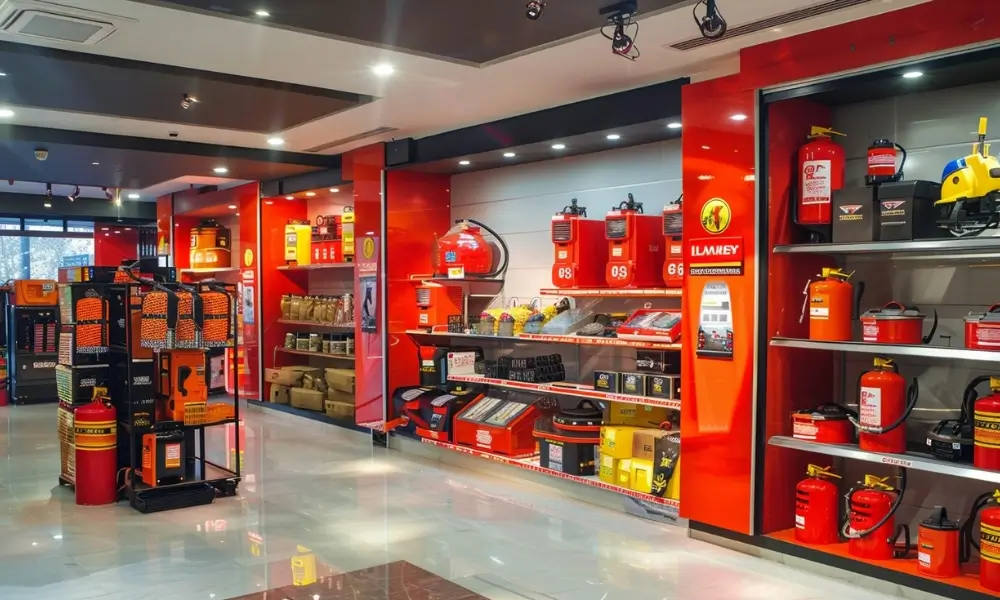In today’s blog, we delve into the critical world of fire safety equipment, exploring the myriad of tools, devices, and systems designed to safeguard lives and protect property from the devastating effects of fire. From the essential fire extinguisher to the sophisticated automatic fire suppression systems, and from the basic smoke detector to the comprehensive emergency response plans, we cover the essentials that everyone should know.
This comprehensive overview not only highlights the importance of these equipment in mitigating fire-related risks but also serves as a guide to understanding their functionality, application, and role in ensuring a safe environment for all.
What’re Fire Safety Equipments?
Fire safety equipment refers to a wide range of tools, devices, and systems designed to protect lives and property in the event of a fire. This equipment plays a crucial role in preventing fires, detecting them early, suppressing flames, and facilitating safe evacuation. Common types of fire safety equipment include fire extinguishers, sprinkler systems, smoke and heat detectors, fire alarms, emergency lighting, fire blankets, fire doors, and specialized firefighting gear.
In addition to the physical equipment, comprehensive fire safety plans, clear signage, and regular fire drills are essential components of an effective fire safety strategy.
Understanding Fire Safety Equipment
Fire safety equipment plays an essential role in protecting lives and property from fire. It works in various ways to safeguard people and buildings:
- Preventing fires: Flame retardant chemicals applied to materials, fire safety plans outlining safe practices and procedures, and proper storage of flammable materials can all help prevent fires from igniting in the first place.
- Detecting fires early: Smoke detectors, heat detectors, and gas leak detectors are crucial for identifying potential fire hazards at an early stage. Early detection allows for a faster response, giving occupants time to evacuate safely and firefighters a better chance of containing the fire before it spreads.
- Suppressing fires: Fire extinguishers, fire sprinkler systems, and fire suppression systems are designed to extinguish fires. Firefighters also use specialized tools and equipment to combat blazes.
- Helping with safe evacuation: Emergency and exit lights illuminate escape routes during a power outage or smoke-filled environment. Fire doors slow the spread of fire and smoke, buying valuable time for evacuation. Clearly marked exit signs and fire safety plans guide occupants towards designated safe areas.
Different Fire Safety Equipment
Fire safety equipment comprises various tools and devices designed to prevent, combat, and mitigate the effects of fire in residential, commercial, and industrial settings. These are essential for ensuring the safety of individuals and property, and their selection depends on the specific requirements of a building or facility. Key fire safety equipment includes:
1. Fire Extinguishers
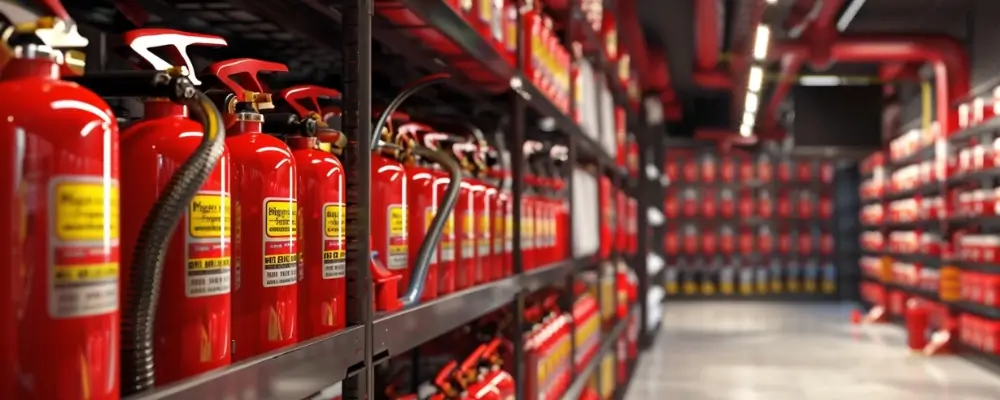
Fire extinguishers are first-response tools for tackling small fires before they escalate into larger, unmanageable blazes. The type of extinguishing agent they discharge is selected based on the class of fire they are intended to combat:
- Water Extinguishers are suitable for Class A fires involving ordinary combustibles like wood, paper, and cloth. The water cools the burning materials below their ignition temperature.
- Foam Extinguishers are effective against Class A and B fires (flammable liquids). The foam forms a blanket over the burning material, starving the fire of oxygen and cooling the fuel surface.
- Dry Chemical Extinguishers contain a powder that interrupts the chemical reaction of the fire. These are versatile and effective against Class A, B, and C fires (electrical equipment).
- Carbon Dioxide (CO2) Extinguishers are primarily used for Class B and C fires. CO2 displaces oxygen around the fire and removes the heat with a cold discharge.
- Wet Chemical Extinguishers are specialized for Class K fires (cooking oils and fats) in commercial kitchens. They work by creating a soap-like solution that cools and smothers the fire.
2. Fire Sprinkler Systems

Fire sprinkler systems are designed to automatically detect fire heat and activate the sprinkler heads in the vicinity of the fire. The system is connected to a water supply and distributes water over the fire area to control or extinguish the fire in its early stages. This immediate response is crucial for preventing the spread of fire and minimizing damage and fatalities.
Sprinkler systems can be designed to cover entire buildings or specific areas, depending on the fire risk and building layout.
3. Smoke Detectors and Fire Alarms

Smoke detectors are critical for early fire detection. They can detect smoke (ionization detectors) or the presence of heat (photoelectric detectors), triggering an alarm that alerts occupants to the danger. Integrating smoke detectors with a building’s fire alarm system ensures a coordinated alert system that can initiate emergency lighting, activate voice evacuation messages, and notify emergency services.
4. Fire Hose Reels and Cabinets
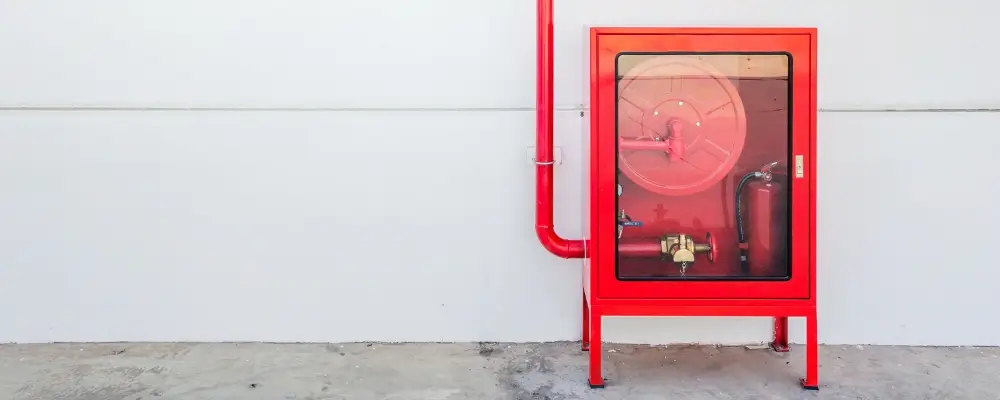
Fire hose reels provide a steady and controllable supply of water to combat fires. Typically installed in strategic locations within buildings, they consist of a long hose reel with a nozzle that can be adjusted for spray and jet functions.
Cabinets protect the hose and equipment from damage and ensure they remain ready for immediate use. They are particularly useful for larger premises where fires may require a more substantial response than portable extinguishers can provide.
5. Emergency and Exit Lights

In the event of a fire, power outages are common, and smoke can severely reduce visibility. Emergency and exit lights ensure that pathways, exits, and critical equipment locations are illuminated during emergencies. These lights have backup power sources, such as batteries, ensuring they remain operational even when the primary power supply is cut. Proper placement of these lights can facilitate a safe and orderly evacuation, guiding occupants to emergency exits and assembly points.
Together, these fire safety equipments form a comprehensive defense against the outbreak and spread of fires. Regular maintenance, testing, and training on the proper use of these equipment are essential for ensuring they function as intended during an emergency.
6. Fire Blankets
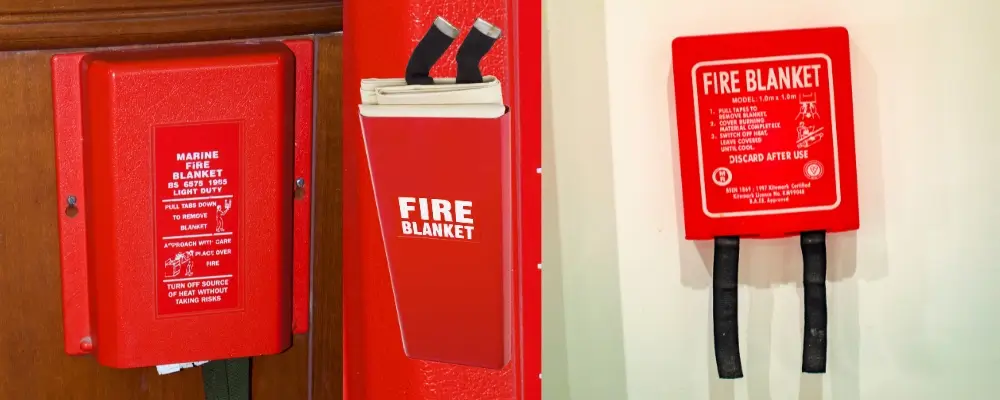
Fire blankets are safety devices made from fire-resistant materials like fibreglass or asbestos. They are designed to extinguish small fires at their initial stage by depriving the fire of oxygen. Here’s how they work and are used:
- Functionality: A fire blanket works by smothering the flames, effectively cutting off the oxygen supply needed for combustion. When placed over a fire, it seals the area, causing the fire to die down due to lack of oxygen.
- Uses: Fire blankets are particularly useful for kitchen fires, such as those caused by cooking oil (Class K fires), or in laboratories where small-scale chemical fires can occur. They are also used to wrap around individuals whose clothing has caught fire, protecting them from burns while extinguishing the clothing fire.
- Advantages: The main benefits include ease of use, no need for maintenance, and the ability to use them on people, which is not advisable with most fire extinguishers.
7. Fire Doors
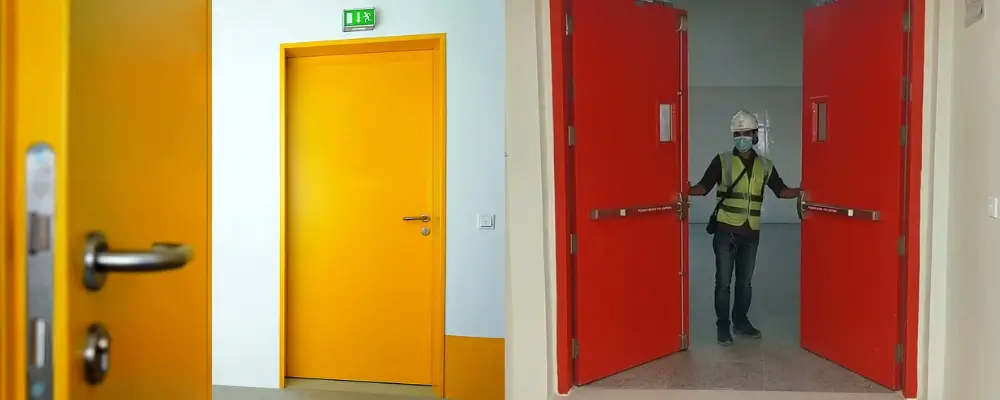
Fire doors are an essential component of a building’s passive fire protection system, designed to prevent the spread of fire and smoke between different sections of a building:
- Construction: They are made from fire-resistant materials such as steel, timber, or gypsum and are fitted with seals that expand in high temperatures, blocking gaps to prevent smoke passage.
- Operation: These doors are designed to close automatically in the event of a fire, typically through the use of fusible links or electromagnetic hold-open devices that release when a fire alarm is activated.
- Importance: Fire doors help contain the fire to a limited area by compartmentalizing the building, protecting egress routes and allowing occupants more time to evacuate safely.
8. Voice Evacuation Systems
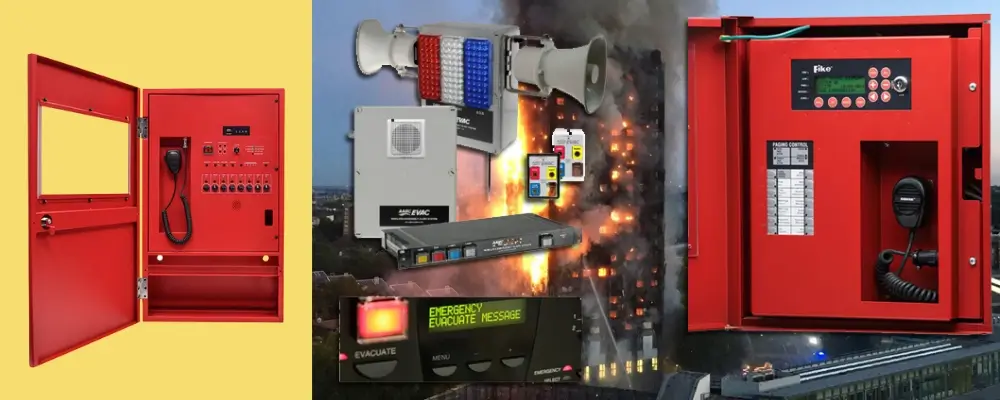
Voice evacuation systems are advanced fire alarm systems that use spoken messages to direct building occupants during an evacuation:
- Efficiency: Studies have shown that voice evacuation messages are more effective at prompting action during an emergency than traditional alarm sounds. This is because specific instructions can be given, reducing confusion and panic.
- Functionality: These systems can provide live or pre-recorded messages with instructions specific to the emergency’s nature and location, often including directions to the nearest safe exit.
- Integration: They are typically integrated with other fire safety systems within a building, allowing for coordinated activation in conjunction with fire detection and suppression systems.
9. Fire Suppression Systems
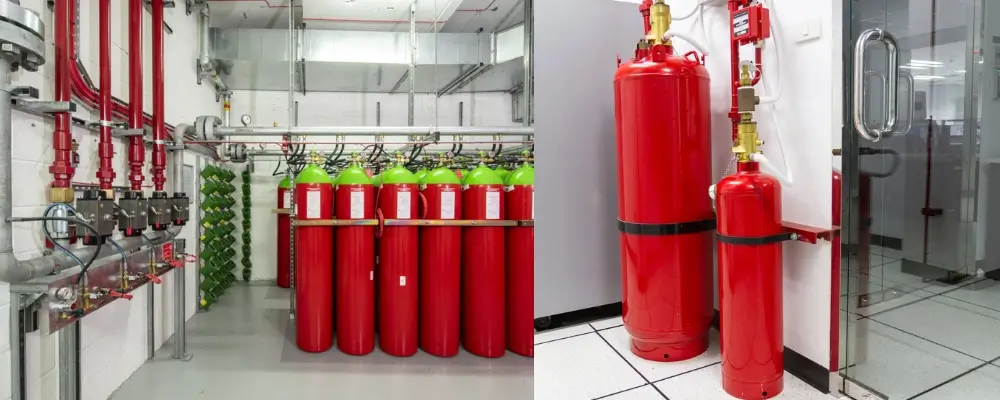
Fire suppression systems use various agents like gases, chemicals, or foam to extinguish fires without the damage associated with water:
Types and Uses:
- Gaseous Systems (e.g., FM-200, inert gases): These systems discharge a gas that reduces the oxygen level around the fire or interrupts the chemical reaction of the fire triangle (fuel, heat, oxygen). They are ideal for data centers, museums, and areas with valuable electronics or art.
- Chemical Wet Agents (e.g., potassium acetate-based agents): Often used in commercial kitchens to suppress Class K fires by cooling and forming a layer that prevents re-ignition.
- Foam Systems: Used for Class B fires (flammable liquids) and sometimes A fires, foam creates a barrier between the fuel and the air, extinguishing the fire and preventing vapour release.
Advantages: These systems are particularly valued for their ability to quickly extinguish fires without harming sensitive equipment, documents, or artwork. They are suitable for use in a wide range of environments, from server rooms to archives and kitchens.
Each of these fire safety measures plays a vital role in protecting lives and property from the threat of fire. Their effectiveness depends on proper installation, regular maintenance, and the readiness of occupants or personnel to use them appropriately in the event of a fire.
Additional Important Fire Safety Equipment
Beyond the basic fire safety equipment, some additional resources and technologies play critical roles in enhancing fire safety in various settings:
Integrating these elements into a comprehensive fire safety strategy can significantly enhance protection against fire risks in any setting. Education and regular drills are key to ensuring that occupants are prepared to respond effectively to a fire.
Conclusion
In conclusion, the significance of fire safety equipment cannot be overstated in its role to prevent, detect, and combat fires effectively. Through this exploration, we’ve seen how each piece of equipment, from extinguishers to emergency lighting, plays a vital part in a comprehensive fire safety strategy. Understanding and implementing these tools and systems is essential for creating safer environments in homes, workplaces, and public spaces.
It’s clear that being equipped with the knowledge of fire safety and the proper use of this equipment can dramatically reduce the risk of fire-related injuries and fatalities, underscoring the importance of preparedness and awareness in protecting lives and property.

